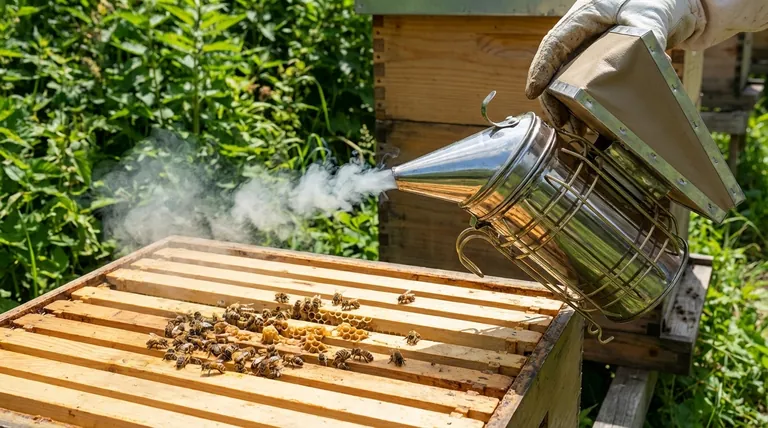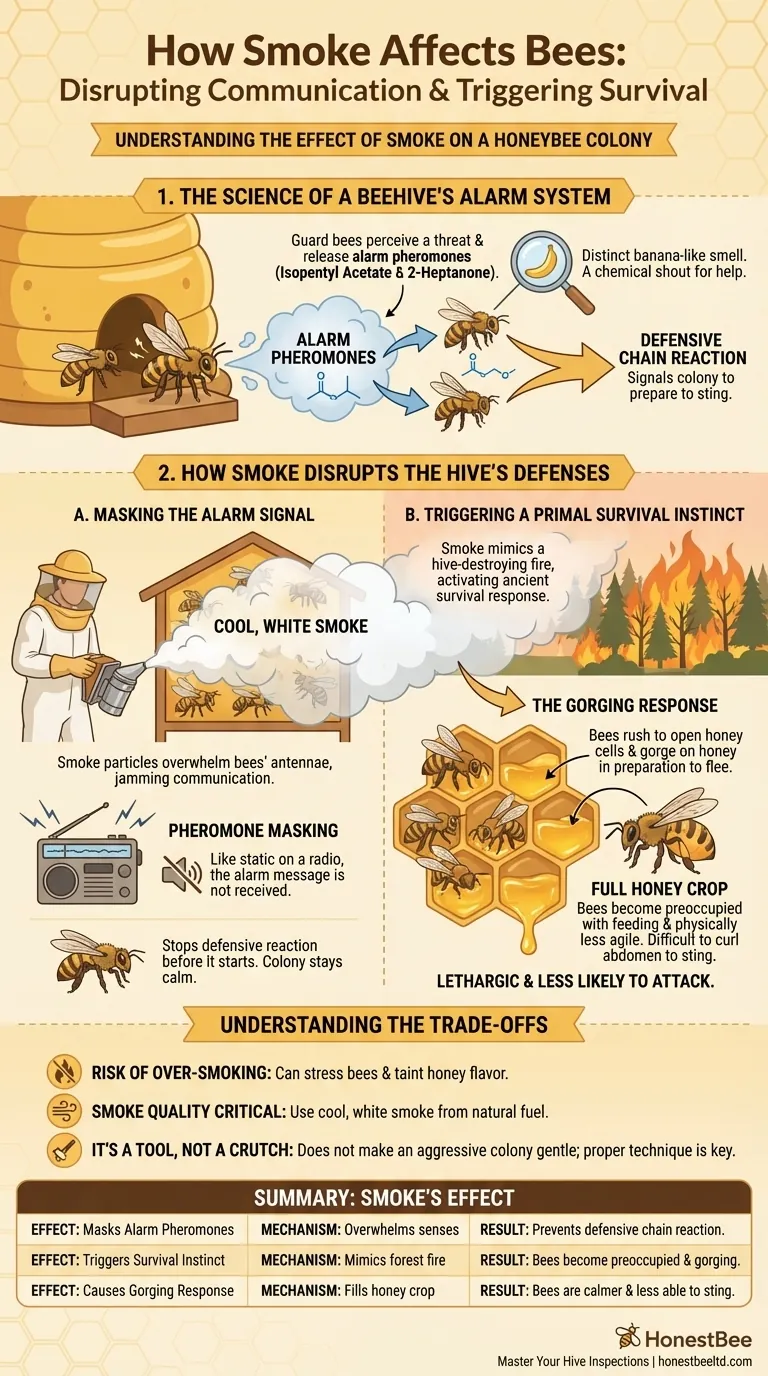To understand the effect of smoke on a honeybee colony, you must see it not as a simple sedative, but as a tool that manipulates two core aspects of bee biology: communication and survival instinct. Smoke works by masking the chemical alarm signals that trigger a defensive response and by tricking the bees into preparing for a hive-destroying fire, which makes them docile and preoccupied.
The use of smoke is a strategic disruption of a hive's natural processes. It overrides the bees' ability to communicate danger and activates a powerful, self-preservation feeding response, temporarily shifting their priority from defense to survival.

The Science of a Beehive's Alarm System
To appreciate how smoke works, we must first understand how a colony defends itself without it. The entire process is coordinated through chemical signals called pheromones.
The Role of Alarm Pheromones
Guard bees are the first line of defense. When they perceive a threat, they release alarm pheromones into the air.
The primary alarm pheromone is isopentyl acetate, which has a distinct banana-like smell. A second compound, 2-heptanone, is also released.
These pheromones are a chemical shout for help, signaling to other bees in the colony that the hive is under attack and that they should prepare to sting.
How Smoke Disrupts the Hive's Defenses
A smoker introduces a controlled, temporary chaos that overrides the hive's finely tuned defensive system in two distinct ways.
Masking the Alarm Signal
The dense particles in smoke effectively "jam" the bees' ability to communicate. It works by overwhelming their primary sensory organs: their antennae.
When a guard bee releases alarm pheromones, the smoke prevents nearby bees from detecting the chemical signal. This pheromone masking stops a chain reaction of aggression before it can even start, keeping the colony calm.
Think of it as loud static on a radio, drowning out the emergency broadcast. The message is sent, but it is never received.
Triggering a Primal Survival Instinct
Smoke also triggers a deeper, evolutionary response related to forest fires. For millions of years, fire has been one of the greatest natural threats to a bee colony.
When bees detect smoke, their instinct tells them the hive may be destroyed and they must be ready to flee. Their immediate priority shifts from defending the hive to consuming resources for the journey.
The Gorging Response
This survival instinct leads to a specific behavior: the bees rush to open honey cells and begin gorging on honey. They fill a secondary stomach, called the honey crop, in preparation to abandon the hive.
This act has two calming effects. First, the bees become intensely preoccupied with feeding. Second, a bee whose abdomen is full of honey is physically less agile and finds it more difficult to curl its body into the proper position to sting. This makes them lethargic and far less likely to attack.
Understanding the Trade-offs of Using Smoke
While effective, a smoker is a powerful tool that must be used with precision and understanding. Misuse can cause more harm than good.
The Risk of Over-Smoking
The goal is to gently disrupt, not to fumigate. Too much smoke is counterproductive. It can overly stress the bees, cause them to consume excessive amounts of winter stores, and can even taint the flavor of the honey.
Smoke Quality is Critical
Always use a cool, white smoke. This is achieved by using natural, untreated fuel like burlap, pine needles, or untreated cotton. Hot, black smoke is an irritant that can harm bees' respiratory systems and will likely agitate them instead of calming them.
It's a Tool, Not a Crutch
Smoke does not make an aggressive colony gentle. It is a temporary aid for inspections. Proper beekeeping technique—using slow, deliberate movements and avoiding crushing bees—remains the most important factor in keeping a colony calm.
Applying This Knowledge for Effective Beekeeping
Your approach to smoking a hive should be guided by your specific goal for that inspection.
- If your primary focus is a quick, routine inspection: A few gentle puffs at the entrance and under the lid are often enough to mask initial alarm signals and keep the colony manageable.
- If your primary focus is a deep hive manipulation (like finding the queen or splitting the hive): A more consistent, but still gentle, application of smoke may be needed to maintain the gorging response and prevent the colony's defensiveness from returning mid-inspection.
- If your goal is to manage a known "hot" hive: Use smoke deliberately to gain entry, but recognize that it is not a magic solution. Be prepared to retreat if the colony's aggression becomes unmanageable.
By understanding why smoke works, you can move from simply using a tool to strategically managing your colony's behavior.
Summary Table:
| Effect of Smoke | Key Mechanism | Result for the Beekeeper |
|---|---|---|
| Masks Alarm Pheromones | Overwhelms bees' senses, preventing communication of danger. | Prevents defensive chain reaction and stinging. |
| Triggers Survival Instinct | Mimics a forest fire, prompting bees to prepare to flee. | Bees become preoccupied with gorging on honey. |
| Causes Gorging Response | Bees fill their honey crops, making them lethargic. | Bees are physically less able to sting and are calmer. |
Master Your Hive Inspections with the Right Equipment
Understanding the science of smoke is the first step; having reliable, high-quality equipment is the next. HONESTBEE supplies commercial apiaries and beekeeping equipment distributors with the professional-grade smokers and fuels needed to apply these techniques effectively and safely.
Let us help you enhance your operational efficiency and colony management.
Contact HONESTBEE today to discuss your wholesale needs and discover how our beekeeping supplies can support your success.
Visual Guide

Related Products
- Stainless Steel Honey Bee Smoker Hive and Honeycomb Smoker for Beekeeping
- Economy Galvanized Beekeeping Honey Bee Smoker for Wholesale
- European Stainless Steel Bee Smoker for Honey Bee Hive
- Professional Bee Smoker with Elongated Spout and Durable Bellows for Beekeeping
- Premium Traditional Copper Bee Smoker with Bellows
People Also Ask
- What is the proper technique for lighting a bee smoker? Master the Layered Fire Method for Calm Hives
- What is the primary purpose of using smoke in beekeeping? Calm Bees for Safer Hive Management
- What is a Smoker and how is it used in beekeeping? The Essential Tool for Calm, Safe Hive Inspections
- What is a bee smoker and how does it work? Master the Tool for Calm, Safe Hive Inspections
- What happens to bees when they sense smoke? Unlock the Secret to Calm Hive Inspections



















